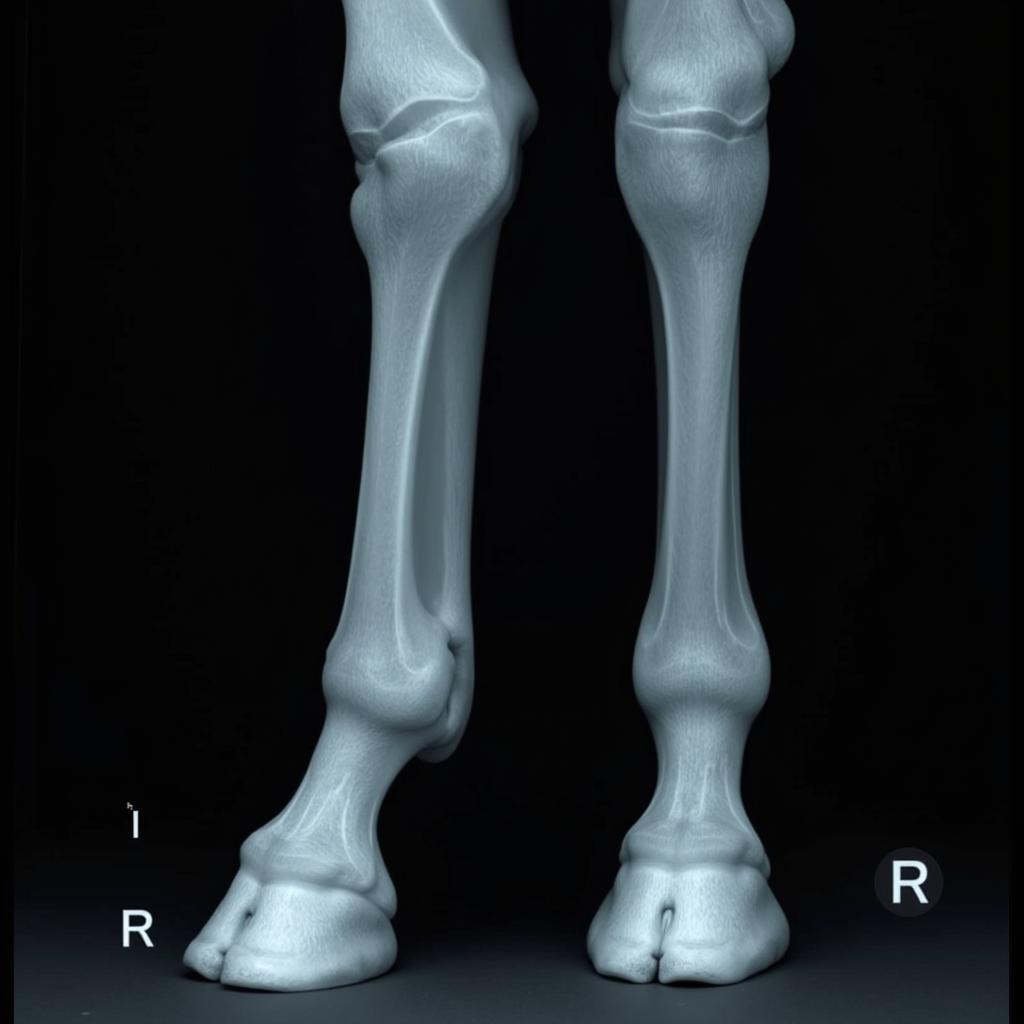Horse Leg X Rays are a crucial diagnostic tool for veterinarians, providing a detailed glimpse into the complex internal structures of a horse’s legs. They allow vets to identify and assess a wide range of conditions, from subtle fractures to chronic arthritis, enabling more effective treatment and management strategies.
Decoding the Details: What Horse Leg X Rays Reveal
Horse leg x rays utilize electromagnetic radiation to create images of the bones, joints, and surrounding soft tissues. These images are invaluable in diagnosing lameness, evaluating injuries, and monitoring healing progress. A horse leg x ray can pinpoint fractures, arthritis, bone spurs, tendon and ligament damage, and other abnormalities that may not be readily apparent during a physical exam.  Horse Leg X Ray: Lateral View
Horse Leg X Ray: Lateral View
For instance, a seemingly minor limp might be revealed as a small fracture in the pastern bone, while persistent swelling could indicate the presence of bone chips or inflammation within a joint. Horse leg x rays allow veterinarians to make informed decisions about treatment, ensuring the best possible outcome for the horse.
Common Reasons for Horse Leg X Rays
Why might a veterinarian recommend a horse leg x ray? Several factors contribute to this decision:
- Lameness: This is the most common reason for x-rays. Whether it’s a subtle head bob or a pronounced limp, any change in a horse’s gait warrants investigation.
- Swelling or Heat: Localized swelling or heat in a leg can signal an underlying problem, ranging from a simple bruise to a more serious injury.
- Trauma: Following a fall, kick, or other traumatic incident, x-rays are essential to rule out fractures and other damage.
- Pre-purchase Examinations: X-rays are often part of pre-purchase exams to evaluate the soundness of a horse before sale.
“X-rays are an indispensable tool,” explains Dr. Emily Carter, DVM, a renowned equine veterinarian. “They allow us to see beyond the surface and pinpoint the root cause of a horse’s discomfort.”
Interpreting the Images: A Closer Look at Horse Leg X Ray Analysis
Veterinarians undergo specialized training to interpret horse leg x rays. They analyze the images for variations in bone density, joint alignment, and the presence of any foreign bodies or abnormalities. This process requires a keen eye for detail and a deep understanding of equine anatomy.
Key Areas of Focus in a Horse Leg X Ray
- Bones: Looking for fractures, chips, spurs, and signs of bone disease.
- Joints: Assessing joint spaces for narrowing, inflammation, and signs of arthritis.
- Soft Tissues: Evaluating tendons and ligaments for tears, strains, or inflammation.
Different Views for a Complete Picture
Multiple views of the horse’s leg are typically taken to provide a comprehensive assessment. These might include:
- Lateral View: Taken from the side of the leg.
- Dorsal-Palmar/Plantar View: Taken from the front or back of the leg.
- Oblique Views: Taken at an angle to visualize specific areas more clearly.
“Different angles offer different perspectives,” adds Dr. Carter. “A combination of views helps us build a complete picture of the horse’s condition.” For those interested in draft quarter horses, you can find more information here: draft quarter horse cross for sale. Understanding different horse coat colors can be fascinating, especially for those interested in gray horses, you might enjoy our articles about gray horse benjamin moore and white gray horse.
What to Expect During a Horse Leg X Ray Procedure
The horse leg x ray procedure is typically straightforward. The area to be x-rayed is cleaned and sometimes clipped to remove hair. The horse may be sedated to ensure stillness, and protective lead aprons are worn by the veterinarian and any assistants. The x-ray machine is positioned, and the images are captured. The entire process is usually quick and painless for the horse.
Horse Leg X Ray: A Vital Tool for Equine Health
Horse leg x rays are an invaluable diagnostic tool, providing crucial insights into equine leg health. They enable veterinarians to identify and address a wide range of conditions, promoting faster healing and improved outcomes for our equine companions. Understanding the power of this technology empowers horse owners to make informed decisions regarding their horses’ well-being. Horse leg x rays, combined with a thorough veterinary examination, play a critical role in maintaining the soundness and longevity of our beloved equine partners. If you are interested in exploring literature related to horses, you may enjoy alice hoffman white horses. Protecting your horse from pests is also vital. Learn more about effective fly repellents here: wipe horse fly repellent.
FAQ
- How much does a horse leg x-ray cost?
- Are horse leg x-rays painful?
- How long does it take to get horse leg x-ray results?
- What are the limitations of horse leg x-rays?
- Can horse leg x-rays detect all types of injuries?
- What should I do if my horse needs a leg x-ray?
- How are horse leg x-rays interpreted?
For further assistance, please contact us: Phone: 0772127271, Email: [email protected] Or visit our address: QGM2+WX2, Vị Trung, Vị Thuỷ, Hậu Giang, Việt Nam. We have a 24/7 customer support team.